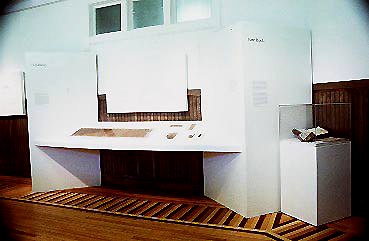
Papyrology
Room
The Papyrology Room is devoted to the collection, documentation and study of
texts written on papyrus, a "paper" product manufactured in Egypt from the
locally cultivated papyrus plant.
The Papyrology Room houses one of the largest collections of inscribed papyri in the world. Approximately 10,000 texts are stored in the Papyrology Room. Nearly all have Egyptian provenances. Together they span a period of two millenia, dating from ca. 1000 BC to AD 1000. A number of different languages are represented: various phases of the ancient Egyptian language (hieroglyphs, demotic, and Coptic), including Greek, and more rarely, Latin. These texts, written on single sheets or long rolls or papyrus, are usually categorized as literary or documentary. Documentary papyri may be legal texts, tax receipts, letters, etc. Thus, papyrology, the study of documentary and literary papyri, contributes to a wide variety of areas of specialized research, including ancient and medieval languages and literature, science, magic, law, economics and religion.
The core of the collections which date to the Hellenistic, Roman and early Byzantine periods, from ca. 300 BC to AD 650, were formed during the 1920s and 1930s from divisions following University of Michigan excavations. Karanis, in the Egyptian region of the Faiyum contributed the largest group of papyri (approximately 1,000 items) to the collection. Papyri with known archaeological contexts, such as those from Karanis, offer a glimpse of the cultural diversity of Egypt during these periods. Fourth-century libraries, for example, could contain copies of both classical dramas and contemporary early Byzantine poetry, and fourth-century archives could contain texts in Coptic and Greek, or archives of census records going back several generations.
In the early years of papyrology, around the turn of the century, when the greatest number of papyri were discovered, archaeological data was not considered to be as important as the text itself and so the provenance of most texts is simply listed as the site of origin. Yet, the ancient traditions of maintaining meticulous and precise textual records, which continued throughout the early Byzantine period, offer a wealth of information about the original location of a papyrus text. Documents with transactions of legal proceedings, for example, are often so detailed that the procedures, the architectural setting and, indeed, the very atmosphere of a trial can be reconstructed (P.Mich. 6922).
Of critical importance for understanding the dynamics of religious development in Egypt during the late Roman and early Byzantine periods are texts describing a wide range of religious activity. Numerous magical texts show that magic remained an important aspect of religious practice in Egypt throughout the Roman and Byzantine periods (P.Mich. 193). The emergence and rapid diffusion of various forms of Christianity in Egypt are attested to by the copying of Christian scripture (P.Mich.6238), "heretical" texts, the extraordinarily rich tradition of letter-writing, and documentary texts such as the third-century libellus displayed here (P.Mich. 263). The libellus is a certificate of sacrifice to the pagan gods of the Roman state -- the sacrifice was a means of identifying all Christians who would refuse to participate in the pagan ritual. The refusers could then be tried for their disloyalty to the state and sentenced to punishments including, imprisonment, torture and death.
Papyrology has contributed to interdisciplinary research projects due to the wide range of research projects incorporating the various subjects contained in its texts. Increasingly, papyrology has come to formulate interdisciplinary studies which assess the papyri as physical objects -- as artifacts. Now, attempts are being made to reconstruct the archaeological contexts from incomplete excavation records, and exact findspots of papyri are being recorded in current excavations. A new expeditionary project for the Papyrology Room, in association with the Department of Classical Studies, is devoted to the conservation and decipherment of an enormous cache of papyrus rolls found in a scriptorium attached to a church in Petra, in Jordan.
Art historians have traced significant formal developments in the manufacture and decoration of ancient books during the early Byzantine period. Perhaps most significant was the adoption of the parchment codex (the square book form we still use today). Literary or documentary texts -- especially those with scientific and magical content -- could be illustrated with diagrams, sketches, or more elaborate illuminations: the format of text illustrations changed in correspondance with the change from roll to codex.
New computer technology aids continued papyrological research as images are digitized and stored for study as well as for display on the World Wide Web.
Return to Table of Contents or continue.